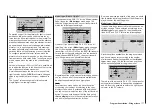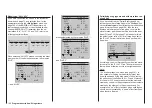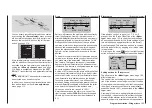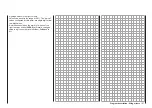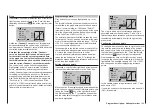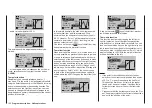
184 Program description - Wing mixers
• “FLAP” and – if present – “FLAP2” column
As the model is braked on the landing approach,
both pairs of flaps can be set to deflect by different
amounts, e. g.:
AI
FL
FL2
FL2
FL
AI
AI
FL
FL2
FL2
FL
AI
• Combining AILE(2) and FLAP(2) for “Crow”
AI
FL
FL2
FL2
FL
AI
Though the airbrake mixers are set as described
above, there is a special flap constellation, called
“crow position” or “butterfly”, that can also be set.
This airbrake setting causes both ailerons move
moderately upward while the flaps move down-
ward as far as possible. Another mixer – see be-
low, under the section “Elevat. curve” – is then used
to trim the elevator such that the flight speed does
not change significantly in comparison to the nor-
mal flight position. Otherwise, there is a danger
that the model loses too much speed and then, af-
ter the braking system is retracted (e. g. to extend
a landing approach that was too short, for exam-
ple), pancakes or even stalls.
A tip for “seeing” the effect of brakes:
Lift the flaps and look over and under the surface
from the front. The larger the surface projected by the
lifted flap, the greater the braking effect achieved.
Tips for activating airbrakes:
• When, in addition to aileron and camber flap ser-
vos, there is also a built-in servo for actuating wing
airbrakes, it can be most simply connected to that
receiver output – if free – whose input has been se-
lected for the brake function, i. e. either on 1, 7, 8
or – if present – 9. If this is not possible then, as an
alternative, use a free mixer to connect the selec-
ted brake control channel with the airbrake servo.
• To activate two airbrake servos, the best ap-
proach is to leave one servo on output 1 and to
connect the second servo to a free output of your
choice – for example, output 9. You then also as-
sign this output to transmitter control 1 (as stand-
ard) on the »Control adjust« menu, page 118,
see figure.
In5
offset
0%
0%
0%
–––
0%
In6
In7
In8
–––
–––
–––
GL
GL
GL
GL
typ
normal
fr
fr
fr
SEL
Cn1
As you do, leave the settings for offset, travel, etc.
at their default values. Also leave the default “GL”
value in the column labeled “TYP” so that the se-
cond airbrake, like the first, operates in the same
way across all flight phases.
fect, although it is not “lost”, since the control travel is
automatically expanded back to 100 %.
Use the select fields of the columns labeled “AILE”,
“AILE2”, “FL” and, if present, “FL2” to specify the
extent and the direction that corresponding flap pairs
are to follow when the airbrake control (control func-
tion 1, 7, 8 or – if present – 9) is operated. If the model
has no airbrakes, leave the corresponding receiver
output free or set it to “Mix-only” in the »Mix-only
channel«, which is available as standard on the
mc-20
HoTT transmitter only, so that you can use
it for other purposes. On the
mc-16
HoTT transmit-
ter this option can be unlocked as an extra-cost op-
tion.
Values in the range -150 % to +150 % are possible.
A simultaneous tap on the
or
keys of the
right four-way button (CLEAR) will reset the given
active (inverse video) field to its default value shown
in the figure.
• “AILE” and – if present – “AILE2” column
When braking the model as it comes in to land,
neither of the aileron flaps should ever be deflect-
ed more than half of the possible travel upwards,
to ensure that enough travel is available to control
the model along its longitudinal axis (aileron func-
tion).
AI
FL
FL2
FL2
FL
AI
Summary of Contents for HoTT MC-16 Series
Page 1: ...Programming Manual mc 16 mc 20 HoTT 1 en mc 16 mc 20...
Page 27: ...27 For your notes...
Page 53: ...53 For your notes...
Page 61: ...61 For your notes...
Page 65: ...65 For your notes...
Page 71: ...71 For your notes...
Page 103: ...103 For your notes...
Page 107: ...107 For your notes...
Page 111: ...111 For your notes...
Page 155: ...155 For your notes...
Page 165: ...165 For your notes...
Page 201: ...201 For your notes...
Page 229: ...229 For your notes...
Page 231: ...231 For your notes...
Page 261: ...261 For your notes...
Page 265: ...265 For your notes...
Page 301: ...301 For your notes...
Page 327: ...327 For your notes...
Page 328: ...328 For your notes...








